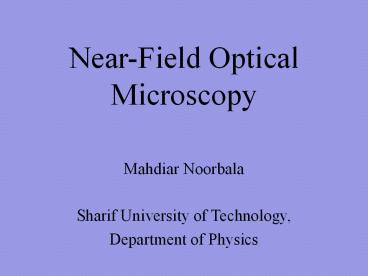Near-Field Optical Microscopy PowerPoint PPT Presentation
Title: Near-Field Optical Microscopy
1
Near-Field Optical Microscopy
- Mahdiar Noorbala
- Sharif University of Technology,
- Department of Physics
2
Outline
- Why another optical microscope?
- What are near-field and evanescent waves?
- Diffraction from sub-wavelength apertures.
- NSOM modes.
- Near-field vs. far-field microscopy.
- NSOM instrumentation.
3
Advantages of optical microscopy
- Imaging a broad range of samples in a variety of
environments. - Noninvasive nature.
- Being convenient and user-friendly.
- Cheapness.
4
The smaller the wavelength of light, the more
information it carries.
- Small wavelengths are not present in the
far-field they decay within a small distance
from the source. In near-field, however, they do
exist! These are called evanescent waves.
5
Light emerging from an aperture NF and FF
6
Light emerging from an aperture NF and FF
- In the far-field region the intensity falls like
1/r2, which is the characteristic of spherical
waves
7
Thus
- The aperture size is to be taken as small as
possible. - The detectors are to be placed as close to the
aperture as possible.
8
Near- vs. Far-Field Microscopy
9
(No Transcript)
10
NSOM modes
a) collection, b) illumination, c)
collection/illumination, d) oblique collection
and e) oblique illumination
11
Generic Design
- Tip production methods.
- Tip position control.
- NSOM combines surface topography and optical
imaging.
12
Tip Production Methods
- Heat-pulling
- Chemical etching (Figure)
13
Tip Position Control
- Prong oscillation at the resonance frequency of
30-100 kHz. - Increase in the signal valley further approach.
- Decrease in the signal hill retraction.
14
Conclusion
- NSOM takes advantage of the information provided
by evanescent waves with high spatial
frequencies. - This requires small aperture size and
illumination of the sample at the proximity. - To implement NSOM, two important elements are
sought tip fabrication and tip position control
. - The overall result is a resolution of around 50
nm.
PowerShow.com is a leading presentation sharing website. It has millions of presentations already uploaded and available with 1,000s more being uploaded by its users every day. Whatever your area of interest, here you’ll be able to find and view presentations you’ll love and possibly download. And, best of all, it is completely free and easy to use.
You might even have a presentation you’d like to share with others. If so, just upload it to PowerShow.com. We’ll convert it to an HTML5 slideshow that includes all the media types you’ve already added: audio, video, music, pictures, animations and transition effects. Then you can share it with your target audience as well as PowerShow.com’s millions of monthly visitors. And, again, it’s all free.
About the Developers
PowerShow.com is brought to you by CrystalGraphics, the award-winning developer and market-leading publisher of rich-media enhancement products for presentations. Our product offerings include millions of PowerPoint templates, diagrams, animated 3D characters and more.

